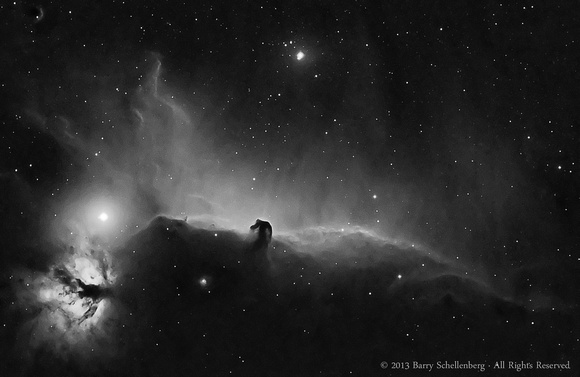Other Names: IC 434, Barnard 33, LDN 1630, M3T 31, [OS98] 52
Optics: Borg Astrograph 101ED at f/4.1
Mount: Atlas EQG using The Sky6, EQMOD, & MaxPilote
Camera: QSI 583WS
Filters: Astrodon Ha 3nm
Exposure: 50 Mins, [5 x 600s] Ha
Accessories: Auto guided with Borg 45ED and Orion Starshoot Auto Guider using Maxim DL guiding
Location: Rodeo, NM
Date: November 17th, 2012
Notes: Processing: Image acquisition with Maxim DL Pro using MaxPilote. Image calibration, align, and combine in Maxim DL Pro. Levels, curves, crop and resize in Photoshop.
Calibrated w/50 Darks, 140 Bias, 100 Flats using light box,
CCD temperature was -20C. Image was taken near the Arizona Sky Village near Portal, AZ.
Winner of Best Overall image for 2014 RASC: Calgary
http://calgary.rasc.ca/aphotowinners.htmhttp://www.calgary.rasc.ca/starseeker/ss1503.pdf High Res Version: http://astromarina.zenfolio.com/img/s8/v82/p1364092532-6.jpg The
Horsehead Nebula (also known as
Barnard 33 in emission nebula
IC 434) is a
dark nebula in the constellation
Orion.
[1] The nebula is located just to the south of the star
Alnitak, which is farthest east on Orion's Belt, and is part of the much larger
Orion Molecular Cloud Complex. The nebula was first recorded in 1888 by
Williamina Fleming on photographic plate B2312 taken at the
Harvard College Observatory. The Horsehead Nebula is approximately 1500
light years from Earth. It is one of the most identifiable nebulae because of the shape of its swirling cloud of dark dust and gases, which is similar to that of a
horse's head when viewed from Earth.
[2] High Res Version:
http://astromarina.zenfolio.com/img/s8/v82/p1364092532-5.jpg


